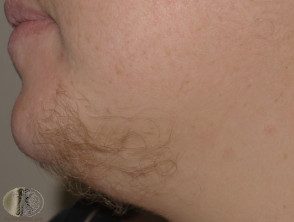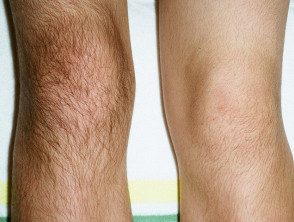Introduction
Excessive hair comprises two entities:
- Hirsutism
- Hypertrichosis.
What is hirsutism?
Hirsutism is a male pattern of secondary or post-pubertal hair growth that occurs in women. It arises in the mustache and beard areas at puberty when hair also appears in non-hirsute women in the armpit and pubic regions. Hirsute women can also develop thicker and longer than normal hair on their limbs and trunk.
Hirsutism is also known as hirsute.
Hirsutism

Facial hirsutism

Facial hirsutism

Facial hirsutism
What is hypertrichosis?
Hypertrichosis is non-hairy overgrowth of hair above normal for age, sex and race of male or female. May refer to unpigmented hair or darker, longer, terminal hairand can be generalized or located.
Hypertrichosis

Hypertrichosis

Hypertrichosis

Hypertrichosis
Who Gets Hirsutism?
Women who are considered hirsute vary depending on culture and ethnicity, as the normal range of secondary hair growth varies with race. It should also be noted that women spend a great deal of time and energy removing unwanted hair, resulting in an abnormally hair-free norm in today's society.
- A shaggy pattern of hair growth is usually determined genetically, confirmed if the male and female members of the family also have more hair than average.
- Late-onset hirsutism may be due to hyperandrogenism, where there is an increase in circulation androgens even testosterone.
Hyperandrogenism is often associated with polycystic ovaries, insulin resistance and obesity. Rare causes include:
- Androgenic drugs
- Cushing syndrome
- Congenital adrenal hyperplasia
- A tumor of the adrenal gland or ovary.
Who gets hypertrichosis?
Hair growth is genetically determined and highly variable. Hypertrichosis can be a subjective complaint of healthy individuals. Pathological hypertrichosis can be congenital or acquired.
Congenital hypertrichosis
-
Congenital hypertrichosis lanuginosa, also known as universal hypertrichosis and congenital terminal hypertrichosis are very rare syndromes with autosomal dominant inheritance.
- Nevoid hypertrichosis is a circumscribed terminal hair growth area. A faun tail on the lower back may be associated with underlying spina bifida.
- Localized hypertrichosis can also be a feature of congenital disease. melanocytic nevus, vascular malformation, Becker naevus and less frequently, other birthmarks.
Acquired hypertrichosis
Generalized acquired hypertrichosis can be associated with:
- Cutaneous porphyria delays
-
Malnutrition, for example, anorexia nervosa
- Malignancy
- A systemic medications such as cyclosporine, phenytoin, androgenic steroids, or minoxidil.
Localized acquired hypertrichosis may be associated with:
- Increased vascularity
- Repetitive rub or scratch (lichen simplex)
- Applying a plaster cast (temporary)
- Repeated application of current minoxidil, a powerful topical steroid, iodine or psoralens (topical PUVA)
- Trichomegaly (long eyelashes) can arise from local bimatoprost or systemic erlotinib.
What Causes Hirsutism?
Different genes expressed in individual hair follicles vary in their response to androgens.
- Hair follicles at secondary hair growth sites are more sensitive to androgens than those in other areas.
- Androgens alter the mesenchymeepithelial cellular interactions, changing the duration of hair growth, dermal papilla size and cell of the dermal papilla, keratinocytes and melanocyte exercise.
- The tiny hair follicles that produce tiny, virtually invisible hairs develop into larger intermediate and terminal follicles that get larger. pigmented hairs
What causes hypertrichosis?
Hypertrichosis is due to a non-hormonal alteration in hair growth driven by genes and cytokines. The precise causes in an individual are often unknown.
What are the clinical features of hirsutism and hypertrichosis?
Hirsutism is usually first seen in the late teens and tends to become more severe as a woman ages. Hypertrichosis can be present at birth or appear at any time thereafter. The affected areas vary.
Hirsutism is usually isolated. It can involve a single site or multiple sites.
- Facial hair: mustache, beard, eyebrows
- Abdomen: a diamond shape of pubic hair that extends to the belly button
- Chest: around the nipples or a more extensive growth
- Upper back
- Inner thighs
The severity of hirsutism is assessed using a modified version of the Ferriman-Gallwey visual. scale for nine areas of the body. The score ranges from 0 (no hair) to 4 (extensive hair growth) in each area.
- Total score <8: crecimiento normal del cabello
- Total score 8–14: mild hirsute
- Total score ≥ 15: moderate to severe hirsute
Ferriman-Gallwey visual scale to assess hirsutism

Ferriman-Gallwey visual scale to assess hirsutism
General examination
A general exam can reveal clues to the cause of hirsutism.
- Acanthosis nigricans suggests insulin resistance.
- Galactorrhea suggests hyperprolactinemia.
- Purple stretch marks, thin skin, bruises, and facial plethora suggest Cushing's syndrome.
-
Virilization suggests hyperandrogenism. The signs include:
- Deep voice
- That is going bald
- Acne
- A decrease in the size of the breasts.
- Clitoral enlargement
- Increased muscle mass.
Complications of hirsutism and hypertrichosis.
People affected by excess hair can suffer great embarrassment with psychosocial Effects Can be time consuming and costly to remove hair.
Other complications may arise from the underlying disease, if any.
How are hirsutism and hypertrichosis diagnosed?
Hirsutism and hypertrichosis are diagnosed clinically. Investigations are generally not necessary unless the Ferriman-Gallwey score is> 15 when performing blood tests to assess male hormone levels and underlying conditions.
Free androgynous The index is the total testosterone concentration divided by the concentration of sex hormone binding globulin and multiplied by 100. If it is elevated, check:
- Dihydroxyepiandrosterone sulfate (elevated if the androgen is of adrenal origin)
- Androstenedione (elevated if the androgen is of ovarian origin).
If hirsutism starts early, premature adrenacheand a family history of congenital adrenal hyperplasia:
- 17-hydroxyprogesterone.
If the characteristics of Cushingoid:
- Urinal and serum cortisol or dexamethasone test overnight.
If menstrual disorder:
- Luteinizing hormone (LH) and follicle stimulating hormone (FSH)
- Prolactin
If symptoms suggest poor general health:
- Thyroid function
- Glucose
- Lipids (cholesterol and triglycerides)
- Images, according to any symptoms.
If you suspect polycystic ovaries:
- Perform a pelvic exam
- Abdominal / transvaginal ultrasound examination of the ovaries.
The diagnostic features for polycystic ovary syndrome are:
- Oligo / anovulation
- Clinical / biochemical signs of hyperandrogenism.
- Presence of ≥ 12 follicles in each ovary measuring 2 to 9 mm in diameter and increased ovarian volume (> 10 ml) on pelvic / transvaginal ultrasound (optional).
If there is skin fragility or blisters in places exposed to the sun:
- Urinary and fecal check porphyrins.
If there is a faun's tail:
- Image of the lower spine.
What is the treatment for hirsutism and hypertrichosis?
Bleaching makes excessive hair less obvious.
Physical methods of hair removal.
Hair removal (waxing and waxing) should be repeated regularly as the hair continues to grow back. The methods include:
- Shaved off
- Depilatory creams
- Hair removal
- Electric epilators
- Electrolysis and thermolysis.
-
Intense pulsed flash lamps and lasers.
Depilatory creams containing eflornithine are available by prescription in some countries.
Medical treatment of hirsutism
Some women with hirsutism can be treated with antiandrogens with variable response. This option is not useful in hypertrichosis. Medications to consider include:
- Oral contraceptives
- Cyproterone
- Spironolactone
- Flutamide
- Finasteride
- Low dose glucocorticoids
- Metformin
- Rosiglitazone.
How can hirsutism and hypertrichosis be prevented?
It is not yet possible to prevent genetically predetermined excessive hair growth. The insulin resistance associated with obesity can be reduced through weight loss and diet. control.
What is the outlook for hirsutism and hypertrichosis?
Forecast It depends on the cause. The most common types of excessive hair growth persist throughout life. Hirsutism tends to be more pronounced with age.
